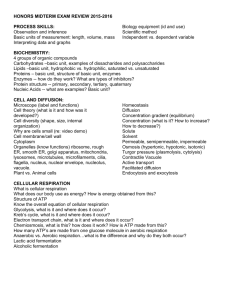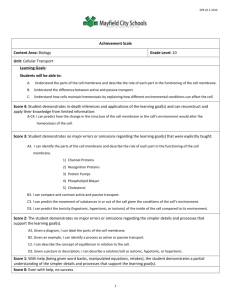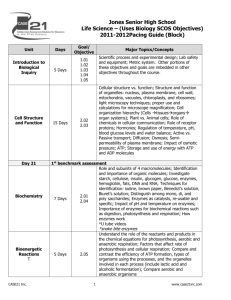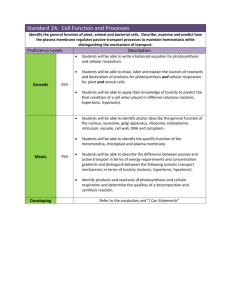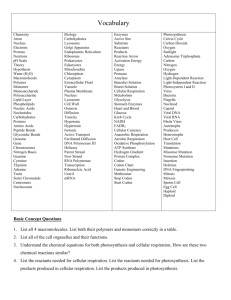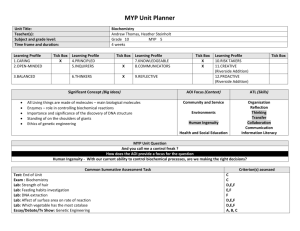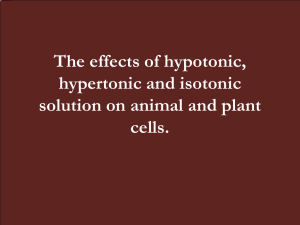AP Biology 2: Final Exam Review Fall 2011
advertisement
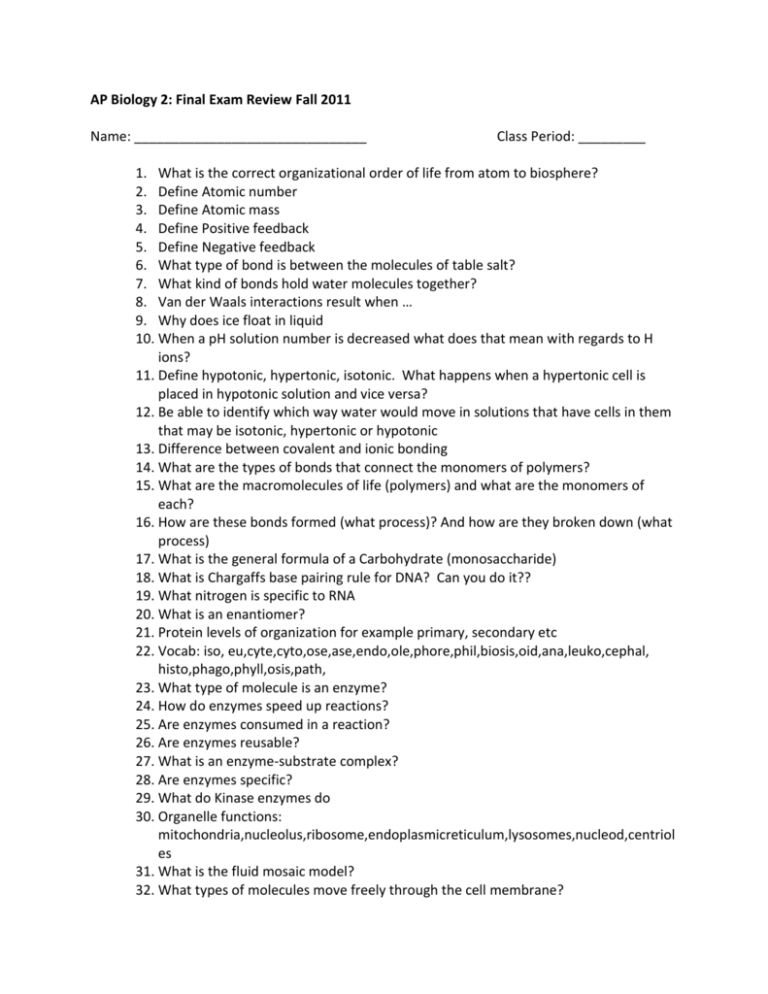
AP Biology 2: Final Exam Review Fall 2011 Name: _______________________________ Class Period: _________ 1. What is the correct organizational order of life from atom to biosphere? 2. Define Atomic number 3. Define Atomic mass 4. Define Positive feedback 5. Define Negative feedback 6. What type of bond is between the molecules of table salt? 7. What kind of bonds hold water molecules together? 8. Van der Waals interactions result when … 9. Why does ice float in liquid 10. When a pH solution number is decreased what does that mean with regards to H ions? 11. Define hypotonic, hypertonic, isotonic. What happens when a hypertonic cell is placed in hypotonic solution and vice versa? 12. Be able to identify which way water would move in solutions that have cells in them that may be isotonic, hypertonic or hypotonic 13. Difference between covalent and ionic bonding 14. What are the types of bonds that connect the monomers of polymers? 15. What are the macromolecules of life (polymers) and what are the monomers of each? 16. How are these bonds formed (what process)? And how are they broken down (what process) 17. What is the general formula of a Carbohydrate (monosaccharide) 18. What is Chargaffs base pairing rule for DNA? Can you do it?? 19. What nitrogen is specific to RNA 20. What is an enantiomer? 21. Protein levels of organization for example primary, secondary etc 22. Vocab: iso, eu,cyte,cyto,ose,ase,endo,ole,phore,phil,biosis,oid,ana,leuko,cephal, histo,phago,phyll,osis,path, 23. What type of molecule is an enzyme? 24. How do enzymes speed up reactions? 25. Are enzymes consumed in a reaction? 26. Are enzymes reusable? 27. What is an enzyme-substrate complex? 28. Are enzymes specific? 29. What do Kinase enzymes do 30. Organelle functions: mitochondria,nucleolus,ribosome,endoplasmicreticulum,lysosomes,nucleod,centriol es 31. What is the fluid mosaic model? 32. What types of molecules move freely through the cell membrane? 33. Decribe the stages of Mitosis… what happens in each and what does it look like? 34. What is interphase? 35. When does DNA replicate in the cell cycle? 36. What is the longest phase of the cell cycle?4 37. What is the endosymbiotic theory? 38. Be able to identify a plasma membrane and the parts of it 39. What is paracrine signaling? Is it local or distant? 40. What is hormonal signaling? Is it local or distant? 41. What is synaptic signaling? Is it local or distant? 42. What are gap junctions and plasmodesmata? 43. What are the three steps in cell signaling in order? 44. What are commonly found pigments in plants 45. The oxygen that comes from photosynthesis comes from the breaking of… 46. What are the two main steps in photosynthesis 47. What is the diff between the pigments a plant absorbs vs reflects. 48. Where is ATP synthase located in a plant cell? 49. What is the main product of cyclic electron flow 50. What are the main waste products of anaerobic respiration? 51. Oxidation / Reduction … which is which? 52. What is the correct order of the stages of cellular respiration? 53. Which stage of the above is common to both aerobic and anaerobic respiration? 54. What is the main end product of glycolysis? 55. What is the main useful product of the Calvin Cycle? 56. What are the main differences between mitosis and meiosis 57. What is the difference between a benign and malignant tumor? 58. What is haploid and diploid? 59. When does crossing over take place? What are the parts of the crossing over process? 60. Which nitrogen bases pair with each other in the DNA molecule? How did they figure this out? 61. Review how DNA makes of copy of itself including being familiar with the parts of Strands such as 5’ and 3’, Okazaki fragments, leading and lagging strands. 62. Use your Vocab and Term list from Chapters 19 and 20 to review for that portion of the Final.

